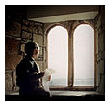Alpha and Omega are also numbers (4)
Posted by Moderator on Apr 14, 2011 in Mathing | 0 commentsIt’s not particularly difficult to write in numerical literary style. The last three posts in this series were about the significance of the number 496, so naturally they were all 496 words long. It’s as simple as that to make a start.
One day, I’d like to emulate my hero—the author of the fourteenth century poem, Sir Gawain and the Green Knight—but I’ve a very long way to go before I reach the exalted heights of numerical artifice he achieved.
Numerical literary style has its detractors. They come in various ilks. Some critics agree that some ancient texts show a mathematical architecture, but think the motive is numerological. Others simply deny outright that any premeditated arithmetic design exists, preferring to explain away structural details as scribal error. ‘Why would anyone,’ they scoff, ‘mix words and numbers? Why would anyone restrict the creative impulse by confining themselves to a rigid mathematical framework?’
I’d like to try these questions on a Japanese master of haiku, the 17-syllable poem of three lines in a 5-7-5 pattern. Behind the blank inscrutable stare I’d get, I’m sure there’d be the incredulous thought: ‘Don’t you get it? A true craftsman doesn’t find strict form a restraint, but freedom.’
read more


